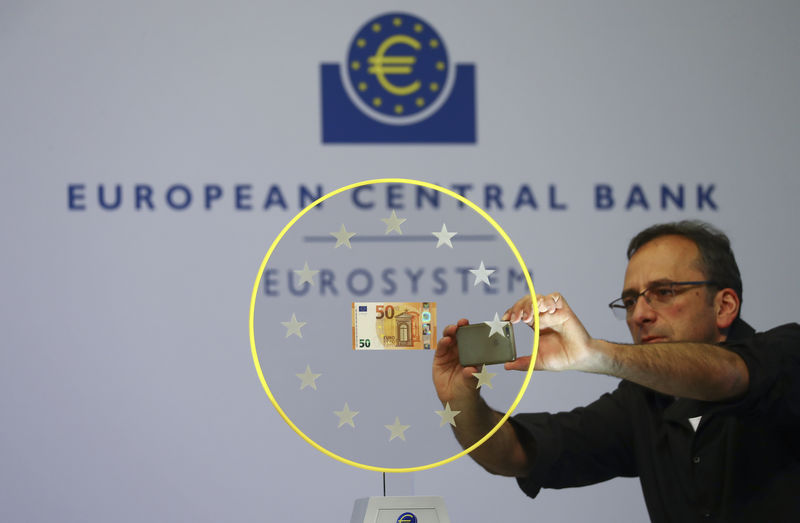
Markets underprice how far the ECB will ease next year: BCA
Investing.com — The European Central Bank (ECB) is poised to implement deeper rate cuts than markets currently anticipate, as per analysts from BCA Research.
The gap between market expectations and BCA’s outlook comes from BCA’s belief that worsening economic conditions in the Eurozone, especially rising inflation and recession risks, will push the ECB to cut rates more aggressively than the market currently expects.
Markets are underpricing the scale of monetary easing, particularly in 2025, as the Eurozone faces mounting economic challenges that will necessitate significant policy responses.
The ECB has already lowered its deposit rate to 3.5% from 3.75%, with another cut expected in December.
These gradual rate cuts follow the ECB’s new strategy introduced earlier this year. However, the market, shown by the €STR curve, has priced in the possibility of an earlier cut in October, giving it a 50% chance.
BCA Research, though, sees this as premature and believes it’s based more on speculation than real economic factors.
Several key indicators argue against a more immediate rate cut. Services inflation remains high at 4.2%, driven by pricing in recreation and insurance.
Although this inflationary pressure is expected to ease, it provides enough of a rationale for the ECB to delay additional cuts until December.
Despite the current elevated inflation, BCA expects inflationary pressures to ease over time, driven by several key factors.
Unit labor costs and profits, which have contributed significantly to inflation in recent quarters, are now subsiding.
“As a result, the contribution of unit profits to economy-wide inflation has declined from a peak of 3.6% in Q2 2023 to 1.1% in Q1 2024 ,” the analysts said.
Moreover, labor market conditions are softening. Growth in wages is decelerating, and job creation has weakened. In fact, the employment component of the Eurozone’s Composite PMI has fallen below the key boom-bust line, signaling deteriorating labor demand.
As a result, wage growth is expected to slow further, reducing the inflationary pressure from labor markets.
Additionally, disinflationary forces from the goods sector will persist. Capacity utilization in the Eurozone’s manufacturing sector has dropped to levels last seen during the Sovereign Debt Crisis, with German utilization nearing Great Recession lows.
The contribution of non-energy industrial goods to inflation has fallen to just 0.1%, while energy prices have started to subtract from inflation due to weak oil prices.
BCA suggests that the market is underestimating how far the ECB will need to ease monetary policy in 2025. The €STR curve currently prices at a policy rate of 2% by mid-2025, reflecting market expectations of a soft landing for the Eurozone economy.
“In practice, this means that the ECB is likely to cut rates more in 2025 than the €STR curve anticipates because the Eurozone will suffer a recession next year,” the analysts said.
One major concern is the deteriorating global industrial outlook. The Global Manufacturing PMI has slipped to 48.8, signaling contraction, while US housing activity has slowed, with residential investment expected to decline at an annual pace of 8.5%.
These factors point to a likely recession in the US, which will have spillover effects on European investment, particularly through trade and profit linkages.
Further compounding the problem is weakening consumer confidence in Europe. Real wages, although growing, are being outpaced by rising savings rates, signaling a precautionary approach from households. If labor markets continue to weaken, as expected, consumption will also decline, further undermining economic growth. This combination of declining investment and consumer spending sets the stage for a Eurozone recession in 2025.
In response to these conditions, BCA expects the ECB to cut rates more aggressively than currently anticipated by markets.
With the Eurozone’s neutral real interest rate (r-star) estimated between -0.5% and 1.1%, and the median nominal neutral rate at around 2%, BCA argues that a recession will necessitate cuts that bring the ECB’s deposit rate below 2% by mid-2025.
BCA Research flags several key investment takeaways from its analysis. First, the brokerage remains bullish on German bunds, as deeper-than-expected rate cuts will drive yields lower.
BCA’s “Golden Rule of Bond Investing” states that when central banks cut rates more than anticipated by money markets, bond yields typically decline. This implies further upside for German sovereign bonds, particularly in the face of a slowing economy.
The euro, on the other hand, is likely to face downward pressure. While the currency has shown resilience in the lead-up to the first US Federal Reserve rate cut, historical patterns suggest that the euro will begin to weaken once the Fed begins easing.
The combination of weak global growth and the expectation of more ECB cuts than currently priced will further weigh on the euro. BCA recommends selling EUR/USD as the outlook for the European economy continues to deteriorate.
Finally, BCA remains cautious on European credit, advising investors to adopt a conservative stance in this space. The weakening economic outlook and rising recession risks make European credit less attractive relative to other asset classes.
